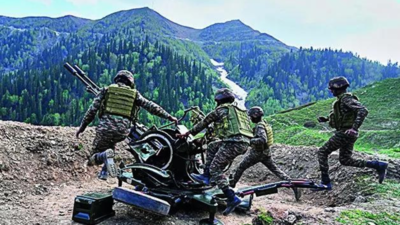ARTICLE AD BOX

With the deep military collusiveness between Pakistan and China being rudely reinforced during Operation Sindoor, India needs to raise its annual defence budget to at least 2.5% of GDP, impart a greater thrust to self-reliance in military R&D and production, and invest heavily in unmanned aerial systems, long-range weapons, space-based systems, electronic warfare and other such tech that will be decisive in future warfare.Modi govt will have to contend with the now well-fused two-front challenge along our long unresolved borders, which will see China continue to use Pakistan as a more than willing proxy to bog India down in South Asia.China is, and will remain, India's main strategic threat in the years ahead. "India will have to tackle a superpower (China), which will also actively continue to support a near-peer military adversary (Pakistan) against us.
We need to continue bolstering both our conventional and nuclear deterrence," a top military officer told TOI.The wide array of Chinese weapons and sensor-shooter networks used by Pakistan during the May 7-10 hostilities, ranging from J-10 fighters firing the PL-15 beyond visual range air-to-air missiles to HQ-9 air defence missile batteries, make this quite evident. It's only going to get worse, with Pakistan on course to acquire at least 40 J-35A fifth-generation stealth jets and even the formidable HQ-19 long-range air defence missile systems from China.
Despite competing demands from other crucial developmental sectors, India simply cannot let its defence budget languish at just about 1.9% of GDP. The bulk of the allocation, as of now, is gobbled up by the huge salary and pension bill as well as operational sustenance, leaving barely 25% for concrete military modernisation. "Emergency procurements approved by govt are more than welcome to plug immediate operational gaps, but the overall budget needs a sharp hike," another officer said.There is also no getting away from the fact that genuine 'Atmanirbharta' in defence production with a much greater role for the private sector, instead of the present half-hearted measures, is critical for systematically building potent capabilities across the spectrum, ensuring adequate war-wastage reserves and surge capacities in crisis situations. "It's critical for retaining strategic autonomy. India will have to fight its battles alone or largely on its own," the top officer said.The indigenous fifth-generation stealth fighter called the advanced medium combat aircraft (AMCA), for instance, needs to be majorly fast-tracked after the defence ministry last month finally approved a new "programme execution model" for prototype development.The long, meandering developmental history of the fourth-generation Tejas, which began way back in 1983, cannot be repeated. The IAF is still waiting to get the first Tejas Mark-1A 'improved' fighter.
Similarly, indigenous development of 110 Kilonewton engines, with or without foreign collaboration, to power AMCA is critical. IAF is currently grappling with just 30 fighter squadrons (each has 16-18 jets) when 42.5 are authorised.Then, there are drones and standoff weapons, which have revolutionised the nature of modern-day combat. From low cross-section loitering munitions and swarm drones to FPV (first person view) drones and UCAVs (unmanned combat aerial vehicles), all need to be produced in India in large numbers.The sheer operational utility of a robust multi-layered air defence also came to the fore during Operation Sindoor, with India using Russian S-400 'Triumf' surface-to-air missile systems (380-km interception range), Barak-8 medium range SAM systems (70-km, jointly developed with Israel), the indigenous Akash systems (25-km) and several short-range systems to thwart multiple drone and missile attacks by Pakistan.Towards this end, DRDO needs to complete its ongoing development of the very short-range air defence system missiles, which have a 6-km range, and the long-range system under Project Kusha, with a 350-km range, on a war footing. Amid all this, long-pending systemic defence reforms like slashing the non-operational flab in the 15-lakh strong armed forces, streamlining long-winded procurement procedures and setting up unified theatre commands for an integrated war-fighting machinery in a cost effective manner, cannot fall by the wayside.



.png)
.png)
.png)
















 1 day ago
10
1 day ago
10









 English (US) ·
English (US) ·